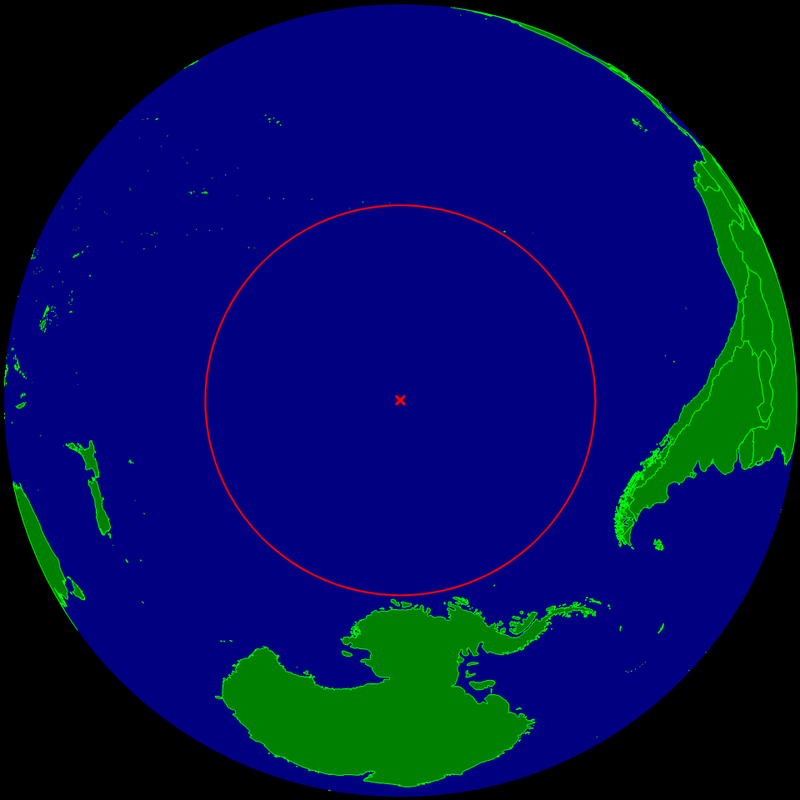The Spaceship Graveyard
Right now, the International Space Station is orbiting the Earth about 200 miles (350 km) above the planet’s surface. It’s far away from any human — except those on the ISS, that is — but that’s mostly a function of how difficult the trip is; 200 miles isn’t very far otherwise. For example, the ISS’s predecessor, the Soviet space station Mir, is even further away from the nearest person. It’s roughly 1,500 miles (2,400 km) from anyone, although it’s hardly alone. It’s in a place known as the spaceship graveyard — the final resting place for more than 150 spacecraft.
Here’s a map, but you won’t see much of anything.

Before we get to that, though, let’s talk about the problem of disused space stuff. The old saying “what goes up must come down” is a canard when it comes to satellites — as NASA notes, when satellites are decommissioned, they often are pushed into a much higher orbit — an additional 185 miles (300 km) away from Earth — effectively pushing it out of the way. And while other items are brought back down, those typically burn up in the atmosphere on re-entry.
But there are exceptions, and those need some place to land. Safely.
The red X is that place, roughly speaking. It’s called the Oceanic Point of Inaccessibility (and often referred to as “Point Nemo“). It’s the farthest point from land. It’s truly the middle of nowhere — even the three dots of land that closest to it (the Pitcairn islands’ Ducie Island, Motu Nui of the Easter Islands, and Antarctica’s Maher Island) are themselves uninhabited. (Although…) Further, the ocean gyres circle around the area, effectively trapping whatever ends up there from within. This combination — it’s nowhere, and it’s hard to leave — make Point Nemo and the region generally a great place for crashing stuff.
So, we’ve crashed a bunch of things there. Mir, as mentioned above, is the most notable; the space station splashed down in 2001, hitting nothing but water. (This was despite Taco Bell’s best efforts; the faux Mexican fast food giant installed a 144 m^2 target in the region, and if a piece of Mir had hit it, everyone in the United States would have been entitled to a free taco.) According to Gizmodo, the spaceship graveyard “is [also] the final resting place of 145 of Russia’s Progress autonomous resupply ships, 4 of Japan’s HTV cargo craft, and 5 of the ESA’s [European Space Agency’s] Automated Transfer Vehicles.” Further, the remains of six of the Soviet Union’s Salyut space stations (predecessors to Mir) are also in the region.
Because the “graveyard” covers such a large area, there’s little chance of ocean-going ships of coming across anything substantial. (There isn’t a lot of marine traffic in the area anyway.) And by and large, whatever wreckage is floating (or more likely, sinking) there is generally not worth the trip — scrap metal and the like. So Mir and its brethren will likely remain in the middle of nowhere for a long time to come.
Bonus fact: You’ll note that NASA doesn’t have a lot of items which splashed down near Point Nemo. NASA aims for other places and, sometimes, misses. In 1979, NASA brought Skylab, an early space station, back to Earth, and aimed for an area in the Indian Ocean, about 800 miles south-southeast from Cape Town, South Africa, per Wikipedia. NASA missed the mark by a lot, and many pieces of Skylab crashed down in the tiny Western Australia town of Esperance. No one was hurt and Esperance had some fun with the unexpected space trash — it fined NASA $400 for littering. (Eventually, a radio DJ paid the fine on behalf of the space agency.)
From the Archives: Just Say No to Gravity: The organization whose mission is the quixotic attempt to control gravity.
Related: A space station for your backyard. (Yes, it’s expensive. But relative to a real space station, it’s practically free.)
